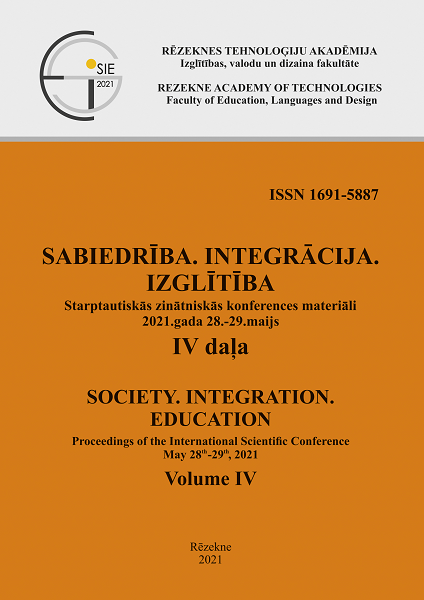DESIGN TRENDS IN CHILDREN'S BOOK ILLUSTRATION - AN EXAMPLE OF LATGALIAN ABC DESIGN
DOI:
https://doi.org/10.17770/sie2021vol4.6255Keywords:
graphic design, alphabet, literacy, children's book visual design, surveyAbstract
Children's book illustrations have always been an area that allows artists to make the most of their creative potential. Modern design trends for children's books are changing both in the world and in Latvia. The most relevant of these are minimalism and color purity, simplicity and quality. Research also highlights the choice of illustration and font style in favor of retro style and handwriting. Picture books on the topics of kindness and love are popular in terms of content. Activity books are useful for interactive communication. The aim of the article is to develop the concept of graphic design of the ABC of Latgalian language by studying design trends in children's book illustration and the supply and demand of children's Latgalian literature in Latvia. Research methods: theoretical - research and analysis of literature and Internet resources, empirical - questionnaire, analysis of analogues.
References
Advocate Art community. (2014). Children's Book Trends, Apr 24 2014. Retrieved from https://www.advocate-art.com/community/2014/04/24/childrens-book-trends
Amsden, R.H. (1960). Children's Preferences in Picture Story Book Variables. Journal of Educational Research, 53, 309-312.
Anstey, M., Bull, G. (2006). Teaching and Learning Multiliteracies: Changing Times, Changing Literacies. International Reading Association (NJ3).
Bobrov, V.I. Chernaya, I.V. (2020). Tekhnologiya poslepechatnykh protsessov: eksklyuzivnye izdaniya. Moskva: Izdatel'stvo Yurayt.
Çer, E., Sahin, E. (2016). Validity of a Checklist for the Design, Content, and Instructional Qualities of Children's Books. Journal of Education and Practice, 7(24), 128-137. Database ERIC.
Chiong, C., DeLoache, J.S. (2012). Learning the ABCs: What kinds of picture books facilitate young children’s learning? Journal of Early Childhood Literacy, 13(2) 225–241. Retrieved from https://journals.sagepub.com/doi/pdf/10.1177/1468798411430091
Evans, M.A., & Saint-Aubin, J. (2005). What Children Are Looking at During Shared Storybook Reading: Evidence from Eye Movement Monitoring. Phychological Sciences, 16(11), 913-920. Retrieved from https://journals.sagepub.com/doi/full/10.1111/j.1467-9280.2005.01636.x
Evans, M.A., & Saint-Aubin, J. (2013). Vocabulary acquisition without adult explanations in repeated shared book reading: An eye movement study. Journal of Educational Psychology, 105(3), 596–608.
Evans, M.A., O’Grady, B., Lavoie, M. (2008). A survey of alphabet books: Looks can be deceiving. Presented at the 69th Annual Canadian Psychological Association (CPA), Convention, Halifax, Canada. Retrieved from https://journals.sagepub.com/doi/full/10.1177/1468798418814103
Evans, M.A., Saint-Aubin, J., Landry, N. (2009). Letter Names and Alphabet Book Reading by Senior Kindergarteners: An Eye Movement Study. Child Development, 80(6), 1824-1841. Database ERIC.
Evans, S. (2019). Using ABC Books to Teach. Retrieved from https://www.fantasticfunandlearning.com/using-abc-books-teach.html
Harris, T.L., Hodges, R.E. (1995). The Literacy Dictionary: The Vocabulary of Reading and Writing. Datebase ERIC.
Justice, L.M., & Lankford, C. (2002). Preschool children's visual attention to print during storybook reading: Pilot findings. Communication Disorders Quarterly, 24(1), 9-19. https://doi.org/10.1177/152574010202400103.
Murray, B.A., Stahl, S.A., Ivey, G. (1996). Developing phoneme awareness through alphabet books. Reading and Writing, 8(4), 307-322. Retrieved from https://www.researchgate.net/publication/226181427_Developing_phoneme_awareness_through_alphabet_books
Nodelman, P. (2001). A is for... What? The Function of Alphabet Books. Journal of Early Childhood Literacy, 1(3), 235-253. https://doi.org/10.1177/14687984010013001
Nowak, S. N. (2015). ABCs by Design: The Role of Alphabet Book Design and Children’s Alphabetic Behaviours in Emergent Literacy Skill Acquisition. Thesis Presented to The University of Guelph, Canada. Retrieved November 1, 2020 from https://atrium.lib.uoguelph.ca/xmlui/bitstream/handle/10214/8922/Nowak_Sarah_201505_PhD.pdf?sequence=1&isAllowed=y
Robertson, J.M. (2016). Influence of the Digital Age on Children’s Literature and Its Use in the Classroom. In K. A. Munger (ed.), Steps to Success: Crossing the Bridge Between Literacy Research and Practice. Retrieved from https://milnepublishing.geneseo.edu/steps-to-success/chapter/7-influence-of-the-digital-age-on-childrens-literature-and-its-use-in-the-classroom/
Stewig, J.W. (1974). Exploring Language with Children. Retrieved from https://books.google.lv/books/about/Exploring_Language_with_Children.html?id=1IZCWZHJJr4C&redir_esc=y
University of California Cooperative Extension (2001). Types of Books to Read to Young Children. In: “READY TO SUCCEED” Programm. Retrieved from https://ucanr.edu/sites/ReadytoSucceed/TypesofBooks/
Zavos, A. (ed.). (2018). Illustrators on the future of designing stock imagery. Retrieved from https://www.shutterstock.com/blog/illustrators-future-imagery






